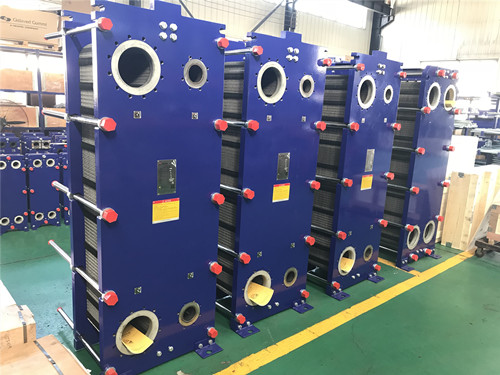How to improve the thermal efficiency of the plate heat exchanger?
So let's talk about the plate heat exchanger first!
I believe everyone is familiar with plate heat exchangers. The name of the heat exchanger seems to be heat exchange. According to the purpose of use, plate condensers, coolers, waste heat recovery, evaporators, etc. can be distinguished.
Waste heat recovery is generally used for waste heat recovery. For example, the plate heat exchanger transfers heat to the cold and heat medium, and the heat exchange efficiency = the heat released by the heating medium / the heat absorbed by the cold and heat medium, which can be seen in this example
Out, the closer the heat released by the heat medium is to the heat absorbed by the cold and heat medium, the higher the heat exchange efficiency.
Let's talk about how to improve the heat exchange efficiency of the plate heat exchanger.
1. Determine the location of the inlet and outlet pipes.
When the single-flow plate heat exchanger is overhauled, the inlet and outlet can be placed on the side of the fixed end plate; the flow rate of the fluid increases with the increase of the temperature difference of the medium.
The heat exchange efficiency of the plate heat exchanger should be increased according to the position of the inlet and outlet of the cold medium from the bottom to the top.
The heat transfer efficiency of the plate heat exchanger is increased by the partition wall heat transfer method, and the heat transfer method of the thin plate heat exchanger is convective heat transfer. As long as the logarithmic average temperature difference and heat transfer coefficient reach a certain value, the plate heat transfer can be improved
The heat exchange efficiency of the device.
3. The flow pattern of the logarithmic mean temperature difference plate heat exchanger can be divided into mixed flow type, downstream type and counter flow type.
Under the same conditions, the logarithmic average temperature difference is small when flowing downstream, and the temperature difference is large when flowing upstream.
The mixture is in between.
Performing countercurrent or near countercurrent to the hot side fluid can increase the temperature of the hot side fluid, lower the temperature of the cold side fluid, and improve thermal efficiency.

Fourth, reduce the thermal resistance of the fouling layer of the thin plate. When the fouling thickness is 1mm, the heat transfer coefficient can be reduced by 10%.
The water quality of the heat exchanger medium should be checked at any time to check whether there is dirt, and the viscous impurities in the water should be treated with a professional filter.
5. Reducing the thickness of the plate and increasing the thickness of the plate can improve the pressure bearing capacity of the plate heat exchanger.
Herringbone plates are adjacent plates that rotate 180 degrees opposite to each other, and through corrugated contact, a fulcrum with high density and uniform distribution is formed.
Make the plate heat exchanger have good pressure bearing performance.
Six. Plates with good thermal conductivity have a variety of materials: stainless steel, titanium plate, Hastelloy, etc. Stainless steel has good thermal conductivity, good stamping performance, and is not easy to be oxidized. Titanium and Hastelloy have good corrosion resistance and are used for media
There are more complicated and corrosive working conditions.
The above is the method to improve the heat exchange efficiency of the plate heat exchanger. You can operate according to your own situation and hope to help you. There are other more detailed questions. Welcome to consult Qingdao Ripter.
【Paper label】:plate heat exchanger
Related information
- This chemical plate heat exchanger is not good and delay production, you are advised to hurry to replace it
- Experienced technical workers tell you: how to detect the plate heat exchanger gasket:
- Reasons for imperfect heat exchanger installation and use
- Why your plate heat exchanger gasket swelling happens?
- Plate heat exchangers for pharmaceuticals are being used by peers with large pharmaceutical sales
- What is the difference between the hanging holes on the plate of plate heat exchanger?
Relevant article
- Heat station supporting plate heat exchanger installation is a technical work, these points should be noted
- Sulfuric acid and other corrosive media for industrial plate heat exchanger requirements are what
- Simple and effective chemical cleaning method of coal chemical plate heat exchanger, can effectively improve efficiency
- A high-quality petrochemical plate heat exchanger in the production of what to consider
- These causes of chemical plate heat exchanger gasket aging you may not know
- Chemical plant plate heat exchanger, sulfuric acid cooling needs attention
- High-end plate heat exchanger customization, specifically for your special working conditions
- The working principle of gasket type industrial plate heat exchanger and the scenarios of its use are worth knowing in depth
- Still worrying about the wholesale price of industrial plate heat exchangers? An article to make you no longer tangled
- The original lubricant in the chemical plate heat exchanger plays so many roles!
Latest information
- Heat station supporting plate heat exchanger installation is a technical work, these points should be noted
- Sulfuric acid and other corrosive media for industrial plate heat exchanger requirements are what
- Simple and effective chemical cleaning method of coal chemical plate heat exchanger, can effectively improve efficiency
- A high-quality petrochemical plate heat exchanger in the production of what to consider
- These causes of chemical plate heat exchanger gasket aging you may not know
- Chemical plant plate heat exchanger, sulfuric acid cooling needs attention
- High-end plate heat exchanger customization, specifically for your special working conditions
- The working principle of gasket type industrial plate heat exchanger and the scenarios of its use are worth knowing in depth
- Still worrying about the wholesale price of industrial plate heat exchangers? An article to make you no longer tangled
- The original lubricant in the chemical plate heat exchanger plays so many roles!








